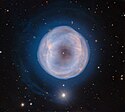IC 5148
| Planetarischer Nebel IC 5148/5150 | |
|---|---|
 | |
| Aufnahme mithilfe des chilenischen Teleskop des Gemini Observatory | |
| AladinLite | |
| Sternbild | Kranich |
| Position Äquinoktium: J2000.0 | |
| Rektaszension | 21h 59m 35,2s [1] |
| Deklination | −39° 23′ 09″[1] |
| Erscheinungsbild | |
| Scheinbare Helligkeit (visuell) | 11,0 mag [2] |
| Scheinbare Helligkeit (B-Band) | 12,9 mag [2] |
| Winkelausdehnung | 2.2' [2] |
| Zentralstern | |
| Bezeichnung | Gaia DR3 6574225217863069056 |
| Physikalische Daten | |
| Entfernung | 3810 ± 240 Lj |
| Geschichte | |
| Entdeckung | Walter Gale Lewis Swift |
| Datum der Entdeckung | 4. Juni 1894 23. Juli 1897[3] |
| Katalogbezeichnungen | |
| IC 5148, 5150 • PK 002-52.1 • ESO 344-005 • AM 2156-393 | |
IC 5148 = IC 5150 ist ein planetarischer Nebel im Sternbild Kranich, der etwa 3.800 Lichtjahre entfernt ist. Der Nebel dehnt sich mit einer Geschwindigkeit von mehr als 50 Kilometern pro Sekunde aus.[4]
Literatur
- König, Michael & Binnewies, Stefan (2023): Bildatlas der Sternhaufen & Nebel, Stuttgart: Kosmos, S. 201
Weblinks
Einzelnachweise
Auf dieser Seite verwendete Medien
Autor/Urheber: International Gemini Observatory/NOIRLab/NSF/AURA Image processing: T.A. Rector (University of Alaska Anchorage/NSF’s NOIRLab), J. Miller (Gemini Observatory/NSF’s NOIRLab), M. Rodriguez (Gemini Observatory/NSF’s NOIRLab), & M. Zamani (NSF’s NOIRLab), Lizenz: CC BY 4.0
IC 5148, nicknamed the Spare Tyre Nebula, is a beautiful planetary nebula located about 3000 light-years away near the ‘neck’ of the southern constellation Grus (The Crane). This image, captured with the Gemini South telescope, one half of the International Gemini Observatory operated by NSF’s NOIRLab, showcases the looming cloud of gas of IC 1548 and the central stellar remnant from which the gas radiates. It’s one of the fastest expanding planetary nebulae, pushing out into space at 180,000 kilometers per hour (112,000 miles per hour).With small telescopes, this nebula looks like a bright central star with an outer ring. The mesmerizing layers of gas are faint. They are almost undetectable without the use of larger telescopes, and not with the clarity captured in this image using the Gemini Multi-Object Spectrograph (GMOS) on Gemini South. Around the time IC 5148 was discovered by astronomers in 1894, researchers coined the term planetary nebula to refer to these giant gaseous balls that looked like giant planets. Today we know that these balls are in fact stellar remnants.At the center of IC 5148 is a white dwarf, the hot core of the dying star, surrounded by asymmetrical gaseous ‘blooms’ and a faint halo ring. The predecessor of the white dwarf was likely a star of a similar mass to our Sun. At the end of that star’s life, the internal pressure imbalance resulted in the star swelling up into a red giant. As it grew, the outer layers of the gas and stellar material were pushed into space to form the nebula we see today. The central hole — the dark patch surrounding the star — is due to the pressure of the radiation from the star that pushes the surrounding gas away from the core and leaves a vacant space. The formation of the ring and the bow-like structures of gas are marks of the evolutionary history of IC 5148 — but the mechanisms that created them remain a mystery to astronomers.
